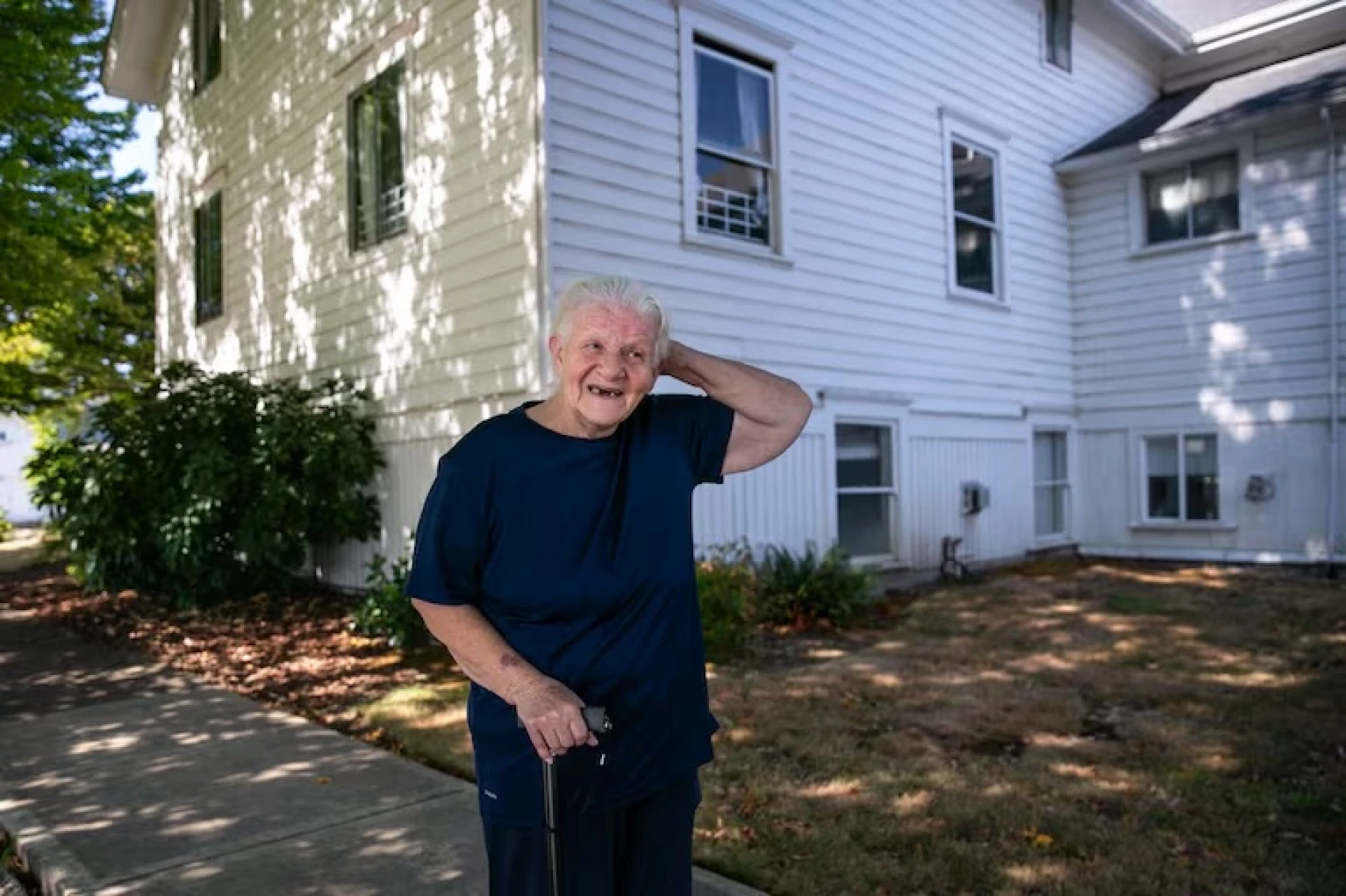As Oregon grows older, more seniors are slipping into homelessness — and the safety net is fraying just when they need it most.
A Pillow on the Passenger Seat
On a clear day in Monmouth, 69-year-old Susan Gallagher parks her faded 1998 Chevy pickup outside a church. Her pillow sits on the passenger seat beside a cane, an inhaler, and a tiny parrot charm dangling from the mirror. She is here for a shower. Gallagher, a caregiver recently evicted from her home, now sleeps across the truck’s two front seats. She wants to live to 103, she says — but today her wish is simpler: “I just wanna go home.”
Gallagher is part of a rapidly growing cohort: older Oregonians experiencing homelessness. In Polk County, about 8% of those receiving county help are older adults. Statewide, more than one in four homeless Oregonians are 55+ — nearly 4,900 people, a share higher than the national average. And in 2024, homelessness among those 65 and older rose 12%.
Also Read
Oregon Crosses a Demographic Threshold
Oregon recently joined the states where people 65+ now outnumber children. The shift is striking in the Portland metro: Multnomah, Washington, and Clackamas counties saw residents 65+ grow about 69% from 2010 to 2024. With baby boomers aging into retirement, experts expect the trend to intensify, stressing a social safety net already under strain.
Fixed incomes such as Social Security (about $1,900/month on average in Oregon) and Supplemental Security Income ($967/month) rarely cover rent, food, utilities, and medicine in a state where median rents are 15% higher than in 2018 and basic costs continue to climb. As AARP Oregon’s Bandana Shrestha notes, the math simply doesn’t pencil out: “There are more older adults than children — and that changes everything about how we plan housing, care, and community.”
One Crisis Away
Gallagher’s path to the truck began with grief and economics. After her son died in 2020, she stayed in his manufactured home in Dallas, Oregon, juggling work and caregiving for her sister. An eviction — the landlord cited “clutter” and an overgrown yard — followed. In the scramble, she lost irreplaceable mementos of her son.
Stories like hers echo across rural counties and city neighborhoods: a medical bill, a car repair, a modest rent hike, a death in the family — one shock pushes an older adult onto the street.
The Shelter Cook Who Once Helped Others
Across from Western Oregon University, Angelita Amaya, 56, cooks barbecue chicken and chile verde in a Monmouth shelter kitchen. She once worked for nonprofits and local government, helping people into housing. Now she lives in the shelter with her adult son, managing congestive heart failure and limited mobility with a powered wheelchair. “I used to help a lot of people get into homes,” she says. “But now I’m on the other side.”
Retirement savings were gutted for many during the Great Recession. A 2024 AARP survey found one in five Americans has no retirement savings. The pandemic then reshaped the labor market, favoring digital skills and flexible work many aging adults lack. The result: older, fixed-income renters competing in a low-vacancy market for units that don’t fit their needs or budgets.
Housing Shortages, Misaligned Supply
Oregon’s construction pace lags far behind demand. Through mid-2025, the state was on track for its third straight annual decline in housing permits — far from Governor Tina Kotek’s goal of 36,000 units per year. And too few of the homes being built are what elders need most: studios and one-bedrooms near transit, groceries, clinics, and pharmacies.
“No one should lose their home after a hardship — or simply because of unaffordable housing prices,” Kotek said, noting efforts to break down barriers to construction and invest in affordable housing. But advocates say the current pipeline still misses the mark for aging, low-income renters.
Safety Net Retrenchment Meets Rising Need
Providers warn the safety net is weakening just as the population ages. Shelters are “full of wheelchairs and walkers,” says Stephanie J. Hooper of AGE+, yet policy doesn’t fully reflect that reality. Recent federal changes to SNAP and Medicaid and state cuts to eviction prevention increase the risk that seniors will lose both food support and health coverage — a double blow that can tip those on the edge into homelessness.
At Church at the Park, which operates shelters in Marion and Polk counties, funding shortfalls led to 29 position cuts (including 16 layoffs), shrinking rural outreach before winter. Chaplain Matt Smucker says roughly half the people seeking help are older adults. “My concern is there’s going to be more vulnerable people without somebody to call who can respond right away.”
Legislative Steps — and Limits
Lawmakers approved a $205 million package earlier this year to stabilize shelters, plus targeted bills to add senior/disabled housing ($24M), fund home accessibility upgrades ($3M), and speed “middle housing”. Yet an $80,000 task force to craft a statewide aging strategy died in committee amid a tighter-than-expected revenue outlook.
“The safety net is fragile at best,” said Rep. Pam Marsh, who chairs the House Housing and Homelessness Committee. “The need for support for these seniors is going to grow — and we need to figure out what that looks like.”
‘Eventually There Comes a Breaking Point’
At Church at the Park, older adult shelter use surged: in 2024, shelters served 319 people aged 55+, compared with 484 total over the program’s first four years combined; 350 people 55+ were on the waitlist at one point last December. Founding pastor DJ Vincent sums it up: “With this population, the story is the economics of rents rising over time. Eventually there comes a breaking point.”
Angela Constantin, 59, knows that point. After her husband died of cancer in 2010, her daughter died in 2022 from a fentanyl overdose. She relapsed, lost work, and became unhoused. Now in Monmouth’s shelter, she’s applying for a janitorial job and waiting on four housing applications. “I want my own house. My own income. My own way of transportation,” she says, tears in her eyes. “Right now I don’t feel like I’m enjoying anything.”
What It Will Take
-
Supply that matches seniors’ needs: Build and preserve small, affordable units near services; protect existing manufactured home communities; prioritize age-friendly design.
-
Prevention over crisis: Restore eviction prevention funding; expand legal aid and flexible rental assistance to stop displacement before it starts.
-
Health + housing alignment: Integrate Medicaid with housing supports, home modifications, and in-home care to help seniors age in place.
-
Outreach capacity: Stabilize funding for rural outreach and mobile services that reach isolated older adults before winter.
Oregon’s population is aging. The question isn’t whether — it’s how the state adapts. For Gallagher, Amaya, Constantin, and thousands like them, the stakes are immediate and personal. A pillow on a truck seat is not a plan for old age. It’s a warning — and a call to build a system where growing old doesn’t mean losing home.












